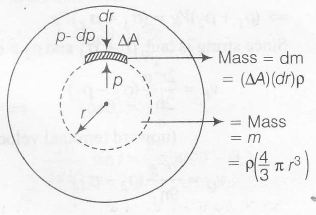Answer:
Option B,C
Explanation:
Gravitational field at a distance r due to mass 'm'
E=Gρ43πr3r2=4Gρπr3
Consider a small element of width dr and are △A at a distance r.
Pressure force on this element outwards = gravitational force on 'dm' from 'm' inwards
⇒ (dp)△A=E(dm)
⇒ −dp.△A={43Gπρr}(△A.dr.ρ)

−∫P0dp=∫rR(4Gρ2π3)rdr
−p=4Gρ2π3×2[r2−R2]
⇒ P=c(R2−r2)
r=3R4,p1=c(R2−9R216)=c(7R216)
r=2R4,p2=c(R2−4R29)=c(5R29)
p1p2=6380
r=3R5,p3=c(R2−925R2)=c(16R225)
r=2R5,p4=c(R2−4R225)
=c(21R225)⇒p3p4=1621